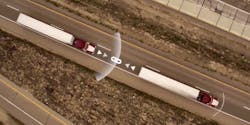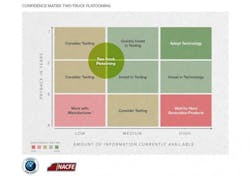Two-truck platooning could deliver 4% average fuel savings
Platooning could potentially deliver a 4% average savings over two trucks in real-world operating conditions, according to Trucking Efficiency’s most recent Confidence Report. That is after accounting for traffic, terrain and time when equipped trucks will not be operating in a platoon, explained Michael Roeth, executive director of the North American Council for Freight Efficiency (NACFE).
Trucking Efficiency, a joint effort between NACFE and the Carbon War Room, released its report on two-truck platooning Sept. 28. According to the report, at a 40- to 50-ft. following distance, the front truck in a platoon can save 4% on fuel and the following truck can save 10%, giving an average of 7% (versus the two trucks not platooning). NACFE also added that platooning would accelerate the adoption of safety equipment, such as collision mitigation and adaptive cruise control, since trucks’ safety systems work together at significantly reduced following distances to overcome aerodynamic drag.
“What we wanted to do here is understand the early stages of a path toward automation trucking,” Roeth said, noting the group sees platooning as the next phase in automated technology, followed by assisted driving, and then, finally, fully autonomous trucks.
Roeth explained that platooning is not fully autonomous/driverless trucking, noting that it is being improperly grouped with that concept.
“We see this as an evolution, not a revolution, in trucking,” he added. “What we see is the braking and accelerating through V2V communications [creates] a reduced drag for both trucks, and the 40- to 50-ft. difference is what we see as a sweet spot.”
Some of the hurdles and unknowns surrounding platooning include payback, driver acceptance, integrity, system security, legislative efforts and public awareness, and shared fuel savings, according to the report.
“The standards aren’t very well defined,” explained Rick Mihelic, NACFE's program director, who also worked on the report. “We’re just going to have to see where it goes over the next few years.”
The group’s study team developed two tools to help fleets make decisions about two-truck platooning:
The Payback Calculator, which uses upfront cost of the equipment, any subscription costs for platooning, the savings in fuel, etc. to calculate the payback of two-truck platooning.
“It’s clearly way too early to understand the cost benefits of platooning and the paybacks that exist,” Roeth explained. “We don’t expect this to be accurate, but directional.”
The Confidence Matrix plots where the two-truck platooning choice falls in terms of available data on the technology and how quickly fleets should realize payback.
Trucking journalist Jack Roberts, who also worked on the report, noted that there is a great deal of concern on the fleet side regarding the safety aspects of platooning. However, he said the safety benefit lies within the automation equipment and improved response time of brake application.
“It takes the lag that a human would have in recognizing a situation and properly responding to it and does it automatically,” Roberts explained. “It reduces the time the brakes have to react; that’s really where the safety part of this comes in.”
Roberts mentioned that the industry and government must release public safety awareness campaigns, particularly to address concerns of cars cutting into platooning trucks.
“This will be different today, a year from now and five years from now,” Roeth said. “NACFE hopes to do some work on the different phases of this. This is a basic understanding and sharing of what we learned.”
About the Author

Cristina Commendatore
Cristina Commendatore is a past FleetOwner editor-in-chief. She wrote for the publication from 2015 to 2023.

